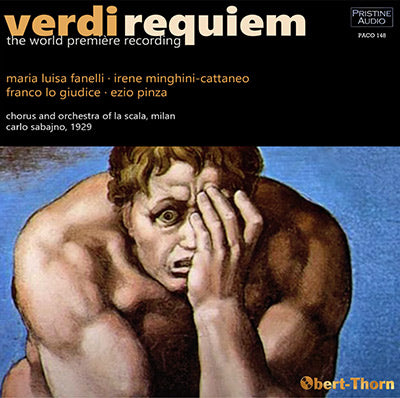
This album is included in the following sets:
This set contains the following albums:
- Producer's Note
- Full Track Listing
- Cover Art
- Historic Review
This world première recording of the Verdi Requiem stood unchallenged in the catalog for ten years until the Serafin version with Gigli superseded it. It never appeared on an “official” LP or CD reissue; and its last new transfer, released nearly 30 years ago, is long out of print.
Those familiar with the 78s will be aware of the myriad technical problems associated with the original recording: hum, microphonic tonal resonances, rumble, car horns outside La Scala, pitch differences on nearly every side, and peak distortion (primarily during the soprano’s high notes). Modern advances in transfer technology have enabled all of these to be cleared up, save for the occasional distortion, and even this has been ameliorated somewhat.
The sources for the present transfer were pre-war American Victor “Z” and “Gold” label pressings, save for the final record, which came from an Italian Disco Grammofono pressing.
Mark Obert-Thorn
VERDI: Requiem
Requiem e Kyrie
1. Requiem aeternam (4:49)
6 September 1929 ∙ CM 1062-2A (HMV D 1751)
2. Kyrie eleison (3:39)
7 September 1929 ∙ CM 1064-2A (D 1751)
Sequence (Dies irae)
3. Dies irae (2:07)
4 September 1929 ∙ CM 1058-2 (D 1752)
4. Tuba mirum (2:13)
5. Mors stupebit (1:12)
5 September 1929 ∙ CM 1059-2 (D 1752)
6. Liber scriptus/*Dies irae (5:23)
6 and *12 September 1929 ∙ CM 1061-1A and *1072-1A [part] (D 1753)
7. Quid sum miser (3:01)
12 September 1929 ∙ CM 1072-1A [part] (D 1753)
8. Rex tremendae (3:32)
3 September 1929 ∙ CM 1056-1A (D 1754)
9. Recordare (3:33)
12 September 1929 ∙ CM 1073-2A (D 1754)
10. Ingemisco (3:39)
8 September 1929 ∙ CM 1066-1A (D 1755)
11. Confutatis/Dies irae (4:35)
5 September 1929 ∙ CM 1060-1A (D 1755)
12. Lacrymosa (4:40)
7 September 1929 ∙ CM 1057-3A (D 1756)
Offertorio
13. Domine Jesu (4:45)
10 September 1929 ∙ CM 1069-2A (D 1756)
14. Hostias (5:25)
10 & 7 September 1929 ∙ CM 1070-1 and 1063-1 [part] (D 1757)
15. Sanctus (2:43)
7 September 1929 ∙ CM 1063-1 [part] (D 1757)
16. Agnus Dei (4:24)
13 September 1929 ∙ CM 1078-1A (D 1758)
17. Lux aeterna (4:51)
8 September 1929 ∙ CM 1065-2 (D 1758)
Libera me
18. Libera me/Dies irae (4:28)
12 September 1929 ∙ CM 1071-2A (D 1759)
19. Requiem aeternam (2:58)
13 September 1929 ∙ CM 1079-3A (D 1759)
20. Libera me (5:37)
9 September 1929 ∙ CM 1067-1 & 1068-3 (D 1760)
Maria Luisa Fanelli (soprano)
Irene Minghini-Cattaneo (mezzo-soprano)
Franco Lo Giudice (tenor)
Ezio Pinza (bass)
Chorus and Orchestra of La Scala, Milan
(Chorus Master: Vittore Veneziani)
Carlo Sabajno (conductor)
Recorded in the Opera House, La Scala, Milan
Producer and Audio Restoration Engineer: Mark Obert-Thorn
Cover artwork based on Michelangelo's The Last Judgement (1536–1541, detail), The Sistine Chapel, Vatican City
Total Timing: 77:34
Reissue Review
[The present recording] is at least valuable as a historic document: after all, it is pretty amazing that so soon after the introduction of the electrical process such a faithful recording of a large choral work could have been made. Carlo Sabajno, who was HMV’s house conductor in Italy and an underrated musician, directs a fierily intense performance that sounds convincing on these CD transfers, apart from the distortion found on the originals. The chorus and orchestra are in many ways superior to their successors on the Columbia Scala set under de Sabata (nla) made 25 years later. The former in particular sing with brio in the Dies irae and with lightness in the Sanctus. It is a raw, somewhat unvarnished performance, not wholly accurate, because in those days retakes were out of the question.
Two of the soloists achieve a high level of conviction. Indeed, neither Minghini-Cattaneo a much underrated mezzo, nor Ezio Pinza have been surpassed on record in this music. The mezzo sings throughout with opulent tone, biting attack and consistent steadiness, and she never forgets to convey the meaning of what she is interpreting. She isn’t over-subtle concerning dynamics. In that respect she is given a lesson by Pinza, who is at all times responsive to what Verdi wrote as regards note values and emphases. Everything he does here is exemplary. Franco Lo Giudice has precisely the right Verdian tang for the tenor’s music and sings with total conviction, but his contribution is spoilt by an over-effusive style, particularly in the “Ingemisco”. The soprano is frankly very bad, singing without a trace of sensibility and in a consistently loud and piercing tone. In spite of her and other failings, I always enjoy this old performance, but it could never be recommended as a first choice.
Alan Blyth
Gramophone review of a previous CD reissue (May, 1990)

